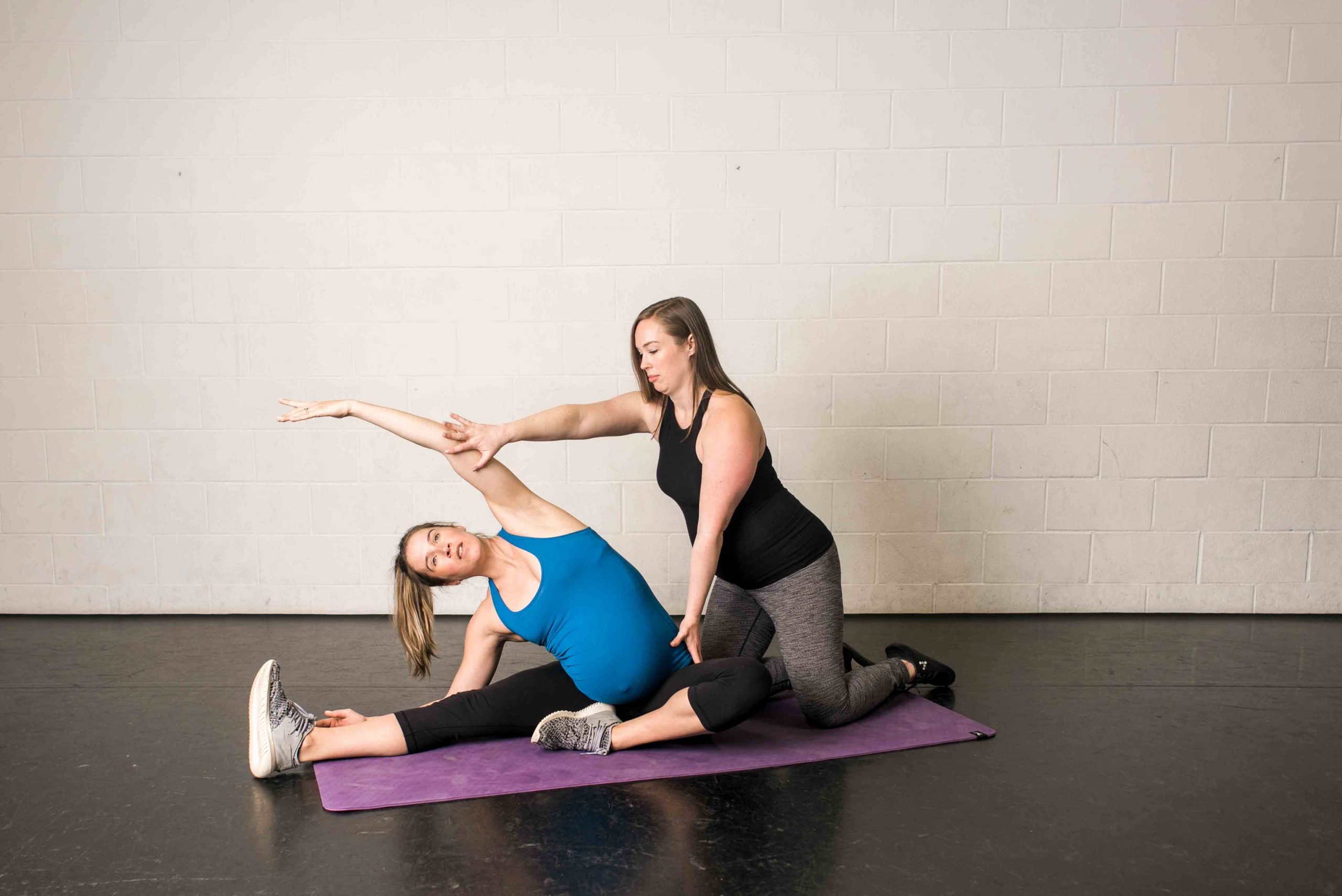Postpartum core training needs to be done RIGHT to help heal the musculature and connective tissue which has been stretched and stressed through pregnancy, labor, and birth (vaginal or C-section).
Unfortunately, many women jump into dangerous and damaging abdominal training soon after baby is born because they think, or have been told, that traditional core exercises will help to re-strengthen their body and “get their abs back”.
(Ps. This Sunday, Feb. 15th, I’m hosting a free webinar that will tell you exactly where postnatal women go wrong with exercise after-baby. A major part of this is core and abdominal training. To get this information, you’ll want to be on the call by registering HERE).
What do I consider potentially dangerous and damaging core exercises on a body after-baby?
• Anything where the belly is bulging up or out, doming up (think: belly’s getting bigger –> crunches, situps, double leg raises)
• Anything where the belly is hanging down towards the floor and you cannot control that downwards pressure effectively through your core, e.g. not just sucking the belly up and in
(think: feeling like you’re going to fall out the front of your belly or feeling like you have downward pressure on the pelvic floor –> front (or even side) planks, pushups)
• Anything where you’re creating a ton of downward force on the pelvic floor and the core cannot stabilize your pelvis and spine adequately (think: leaking urine, back and hip pain from/after exercise, feeling pressure on your pelvic floor/pelvic organs during/after exercise –> running, jumping, plyometrics).
Why do I consider these ineffective exercises?
A postpartum body needs to be retrained to use it’s core properly again, as it’s muscles and tissues are not quite the same as they used to be.
We have to learn how to use our entire core unit (the Core + Floor Five), in it’s current state with the muscles and tissues at different lengths and tensions than they used to be. The above exercises do not train the postpartum core to support the body in the specific ways a postpartum body needs.
– Can you carry the carseat without folding your body to the other side?
– Can you develop stability in your pelvis and low back so picking up your baby from the floor doesn’t throw your back out?
– Can you keep good posture and alignment while holding or carrying your baby?
Even if you did SMART core work in pregnancy, you still have a new body postpartum that needs to undergo some re-training process.
NOTE: I recommend these exercises to women AFTER I know they have done gentle re-training of their core and pelvic floor after baby. This program is how you will want to re-train your core postpartum.
*As always, check with your doctors and physio to ensure you are cleared for exercise.
5 Core Exercises that are safe postpartum (and forever):
1. Clamshells
WHAT TO DO?
Set up so you’re side lying, with the head, hips, and heels aligned. The knees are bent to a 45 deg angle with hips. Place your top hand on your top glutes so you can feel the glutes working and the hips staying completely stable.
Squeeze the top leg glutes, press the heels together, and lift the top knee up towards the ceiling.
WHAT TO FEEL?
Major tension (burning!) in the glutes (bum).
WHAT TO AVOID?
The range of motion is very small in this exercise. Avoid pulling the knee up too high, which will make the hips rock backwards, and the glutes not do their best work.
HOW MANY REPS?
10-20 reps each side.
2. 1/2 Kneeling Pallof Press
WHAT TO DO?
Set up a cable machine attachment or light/medium resistance band between knee and mid-thigh height. Get into “1/2 kneeling stance” (small lunge stance with the back knee rested on the floor) with your body to the side of your attachment and your back leg closest to your attachment point.
Squeeze your back leg glutes right and make sure your ribcage is over your pelvis.
Hold onto your cable or band and pull in into your sternum, so you have both arms bent. With an exhale breath, push your arms straight out in front of the chest. With an inhale breath, return back in to the sternum.
WHAT TO FEEL?
Tension through the core (and whole body) to keep the body from rotating in towards the attachment. Glutes are squeezing strong.
WHAT TO AVOID?
Rotating in towards attachment, or AWAY from the attachment to overcompensate from trying to stay square to the front.
HOW MANY REPS?
8-12 reps each side.
3. 1-Arm Farmer Carry
WHAT TO DO?
Pick up 1 moderately heavy (if you’re earlier postpartum, and/or are managing pelvic organ prolapse, you might want to skip this one, or certainly be cautious with the amount of weight used here) kettlebell or dumbbell.
Hold the weight in one hand, stand in great alignment, gently squeeze the back muscles, and making sure your ribcage is right over top of your hips. Hold the weight slightly out from the side of your body. You should feel the core muscle “kick in” immediately.
Walk at a normal pace, carrying the weight, keeping good alignment.
WHAT TO FEEL?
You want to feel tension through the core to keep your body upright and tall. You’ll feel the abdominals, the muscles through the front of the ribcage, and through the back muscles and lats.
WHAT TO AVOID?
Don’t let the body shift or lean to one side or the other. Avoid the ribcage shifting up and backwards, so that your front ribs would be flaring up (e.g. don’t push the boobs up to the ceiling). You don’t want to feel any pain (anywhere) in your sacroiliac joints and lower back..
HOW MANY REPS?
15-20 seconds walking each side.
4. Elevated Glute bridge
WHAT TO DO?
Lie on your back with the heels lifted up onto a bench, knees at a 90 degree angle. Keep the body in a neutral spine position (put one hand on your belly and one hand on your lower back to help you realize your body for the first few reps).
With your exhale breath, squeeze your glutes to lift the hips and the ribcage up as one unit. Inhale, and return back down to the floor.
WHAT TO FEEL?
Lots of work through your glutes and your hamstrings.
WHAT TO AVOID?
Tucking and rolling your pelvis to lift your body up and down. Keep that neutral spine with the lift and the lower.
HOW MANY REPS?
10-20 reps.
5. Band Pullover With Leg Raise
WHAT TO DO?
Set a light/medium resistance band up at knee height to a cable machine or other secure post. Set a mat up on the floor about 3 feet away from the post.
Grab the band in one hand and lie yourself down on the floor so you’re on your back, with your head closest to the post and feet away from the post. The legs are completely straight, knees pressing down to the floor, feet flexed.
Holding the band with both hands and arms straight, stretched out behind the head. Pull the band with straight arms over the head and stop the pull when the hands are above the chest.
Lift one leg up in the air as much as you can, keeping it completely straight. Lower the leg back down with good control. Repeat on the other side. Take the band back to it’s starting position behind the head.
WHAT TO FEEL?
You’ll feel a lot of work through the back muscles as you pull and hold the band in the position above the chest. You’ll feel work through the abdominals to lift and control the leg raise.
WHAT TO AVOID?
Don’t allow the knees to bend or lift off the floor. Keep your ego in check with the leg raise 😉 Don’t lift the leg higher than your body is allowing, for example your legs are bending, your pelvis is rocking back and forth, or your belly is bulging up.
HOW MANY REPS?
3-5 reps each side.
Add these exercises into your workout warm-ups or do as a stand-alone workout!
JMG
REMEMBER: For more information on core training after pregnancy, join now to secure a spot on my inner circle emailing list.




